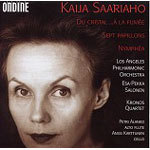
Saariaho: Du cristal, ...a la fumae; Nymphea (Jardin secret III) / Sept Papillons
 $35.00
Out of Stock
$35.00
Out of Stock6+ weeks add to cart
KAIJA SAARIAHO
Saariaho: Du cristal, ...a la fumae; Nymphea (Jardin secret III) / Sept Papillons
Kronos Quartet / Los Angeles Philharmonic Orchestra / Esa-Pekka Salonen, conductor, with Anssi Karttunen, cello
[ Ondine / CD ]
Release Date: Thursday 10 June 2004
This item is currently out of stock. It may take 6 or more weeks to obtain from when you place your order as this is a specialist product.
"In terms of style , Kaija Saariaho has achieved what many Finnish composers have struggled for in vain - to move completely out of the shadow of Sibelius. The performances are stunning. Esa-Pekka Salonen and the Los Angeles Philharmonic combine fastidious precision with an almost Straussian opulence."
***** Five Stars BBC Music Magazine (Sept 04)
Kaija Saariaho (b. 1952) is today one of the world's most significant contemporary composers. She has received several internationally distinguished awards, most recently the Grawemeyer Composition Award for her opera L'amour de loin in 2003. In 1997, she was awarded the title Chevalier à l'ordre des Arts et Lettres in France. Kaija Saariaho has been commissioned by the BBC, Ircam, the New York Philharmonic, the Lincoln Center in New York, the Salzburg Music Festival, the Théâtre de Châtelet in Paris and the Finnish National Opera, among others.
Du cristal ...à la fumée - literally "From crystal into smoke" - is a two-part work in which both sections are written for large symphony orchestra, and each lasts around 20 minutes in performance. There are no soloists in Du cristal, while in ...à la fumée the orchestra is joined by two electronically modified solo instruments, alto flute and cello.
"To my way of thinking, Du cristal ...à la fumée is a single work, two facets of the same image, but both fully drawn in, living, and independent." A diptych, the elements of which have emerged from the same original material, but which are separate, individual, and quite dissimilar works.
The string quartet, of all the musical genres the one most closely bound to its over 200-year history, was perhaps a surprising discovery in Kaija Saariaho's list of published works. The basis of the harmonic world inhabited by Nymphéa lies in the rich spectra of the cello sounds, which the composer has analysed on the computer, using the structures that were revealed as a framework for the harmonies. This also helps to account for the sub-title Jardin secret III, which refers us to Kaija Saariaho's computer software developed at IRCAM and applied in the two previous works in the series.
Sept papillons was the first piece Saariaho wrote after her opera "L'Amour de loin", it was written during the rehearsal period of the opera in Salzburg. One can sense the desire to find a world which has nothing to to do with the opera neither in style nor in language. From the metaphors of the opera which all have an eternal quality - love, yearning and death - she moved now to a metaphor of the ephemeral: butterfly. Still, the opera is present in one or two melodic passages of the piece. Also, from the long time-spans of the opera she moved to these seven miniatures, which each seem to be studies on a different aspect of fragile and ephemeral movement that has no beginning nor end.
Tracks:
Du cristal, ...á la fumée
Nymphéa (Jardin secret III)
Sept Papillons
